- Bernard Preston homepage
- Our green garden
- Crystallised and Creamed Honey
Crystallised and creamed honey
Crystallised and creamed honey are in part totally natural processes that happen to all supersaturated solutions; seeding the liquid makes a lovely smooth texture.
Honey in its natural state has been valued since antiquity as a wonderful food though like most others should be enjoyed in moderation. It is a mixture primarily of two simple sugars, glucose and fructose in varying amounts; and over thirty important enzymes and phytonutrients in tiny fractions.
The ratio of fructose to glucose in the flower nectar, along with the ambient temperature will determine whether it crystallises or not.
Honey from jacaranda flowers for example is high in fructose and tends to stay liquid, especially as it is harvested in summer.
Unprocessed natural honeys that stay liquid are hard to come by in South Africa; you won’t see them often on the shelves. Citrus and kidney beans are two other examples.
Most of the liquid honey you see on the shelves has been heated; and spoiled.
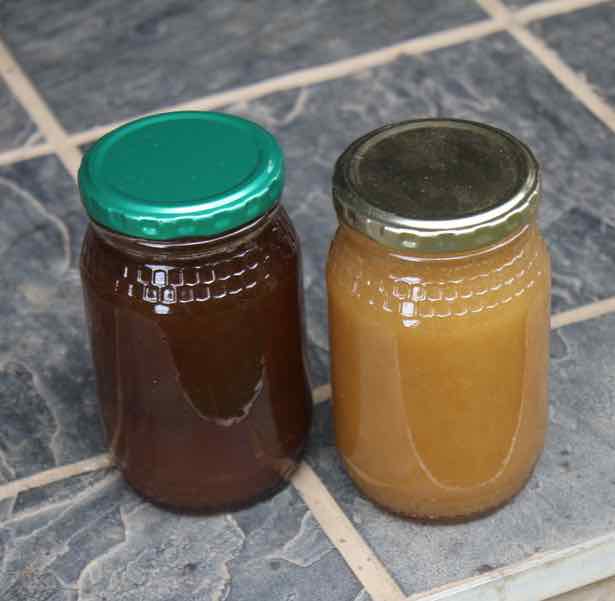 Fresh gum honey starts crystallising within days
Fresh gum honey starts crystallising within daysThe nectar from gum trees is much lower in fructose and so the honey tends to crystallise very quickly; especially as it harvested in autumn and winter when temperatures are much lower.
Without question the most natural form of honey is in the comb; it is completely unrefined with all the goodies intact but it is hard to come by and is very expensive. You are paying for the wax too. All the rest is processed to one degree or another; buyer beware.
Food producers and manufacturers are faced with a difficult moral dilemma; do they supply the public with what they want, or should they give us only what is good for us? The profit motive creeps in too, needless to say. There's a much greater margin on ultra-processed items.
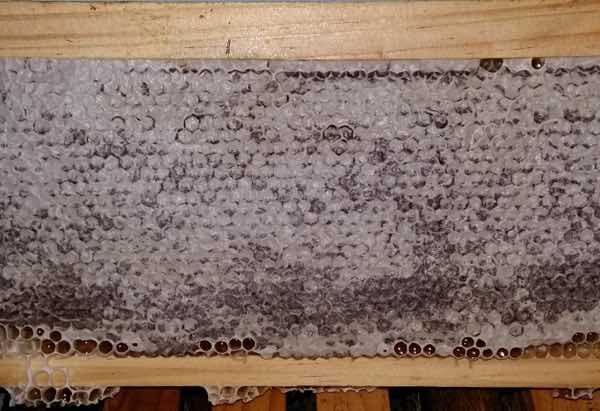 A natural fully-capped honeycomb.
A natural fully-capped honeycomb.No question of it, the public prefers liquid honey from a squeeze bottle; it’s so easy to spread over your cereal or toast. But it most likely has a very high GI.
Honey in the Midlands of South Africa comes primarily from gum trees. As stated above it crystallises quickly; to give the public what they want, bottlers heat it. Then they put it through very fine filters to remove every last vestige of pollen that might act as a seed on which this precipitation might start; it is ultra-processed.
The important enzymes that make honey unique are denatured and frankly it’s a junk food, of little more value than syrup. The volatile fragrances are lost. A purist would not touch it. It also raises the GI dramatically from low to higher than sugar.
Also honey is one of the three most adulterated foods in the world; along with olive oil and dairy products. Unscrupulous bottlers, utterly without any ethical principles, add high-fructose corn syrup which is cheap and very nasty.
Insulin is not responsive to fructose so you can have dangerously high levels of sugars in the blood stream with little protection from the hormone.
Plus the raised proportion of fructose means that it won’t crystallise, giving the public exactly what they want; runny honey. It is estimated that around a half of that on the shelves has been doctored in this way and even experienced beekeepers are often none the wiser.
Part of the reason for this I believe is because we have lost the art of eating our food mindfully, enjoying the textures and innate flavours. It just gets shovelled down whilst watching TV; or we are engrossed in other matters.
Extracting honey from the comb actually increases its value; the nutritious pollens and propolis that help with allergies and inflammation are also spun from the frame and find their way into the liquid-gold. In the Midlands it will tend to crystallise very quickly on these seeds.
It is the safest way to ensure you have a fine product; it should have fine crystals and not separate out.
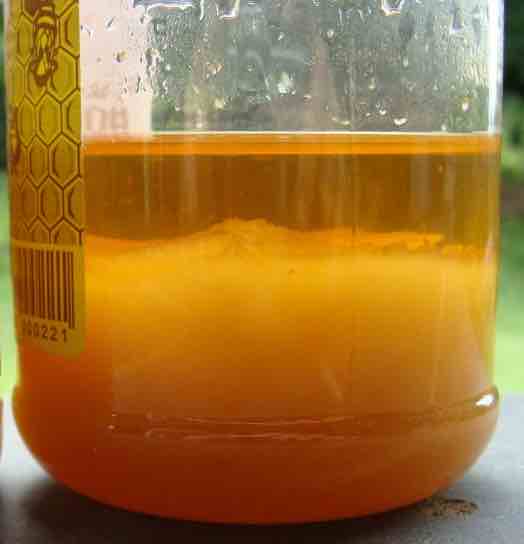 Separation is a sure sign of adulterated honey.
Separation is a sure sign of adulterated honey.Never buy from that label again if you see this happening; you know they are charlatans.
It is often called raw honey, meaning it has not been heated in any way; and should not even have been "warmed" though many beekeepers may bend the rules slightly[1].
It should not, even at the point of contact between the heating element and the honey, be raised above the temperature in the hive; around 40oC. For this reason I have stopped using a hot knife for decapping.
Make a habit of smelling your honey when you first open the bottle; it should have the rich, deeply-scented fragrance of millions of flowers. If it has none at all, or worse gives off an awful stink then you can be sure that it has either been processed or adulterated. Nor should it be sickly sweet.
Set honey
One of the problems with our local gum honey is that when it crystallises it becomes extremely hard; almost like rock. The consumer doesn’t like it. Putting the bottle in a brown paper-bag on a sunny windowsill will soften it.
The other option open to the beekeeper, the one in fact which I have chosen, is to take some of the choice honey from last year and whip it briefly into the liquid just before it crystallises.
Seeding it in this this gives it a very smooth texture that will not be rock-hard. We call this "set" honey. It is beaten in this way for at most a few minutes; there is no intention of whipping air into the mixture.
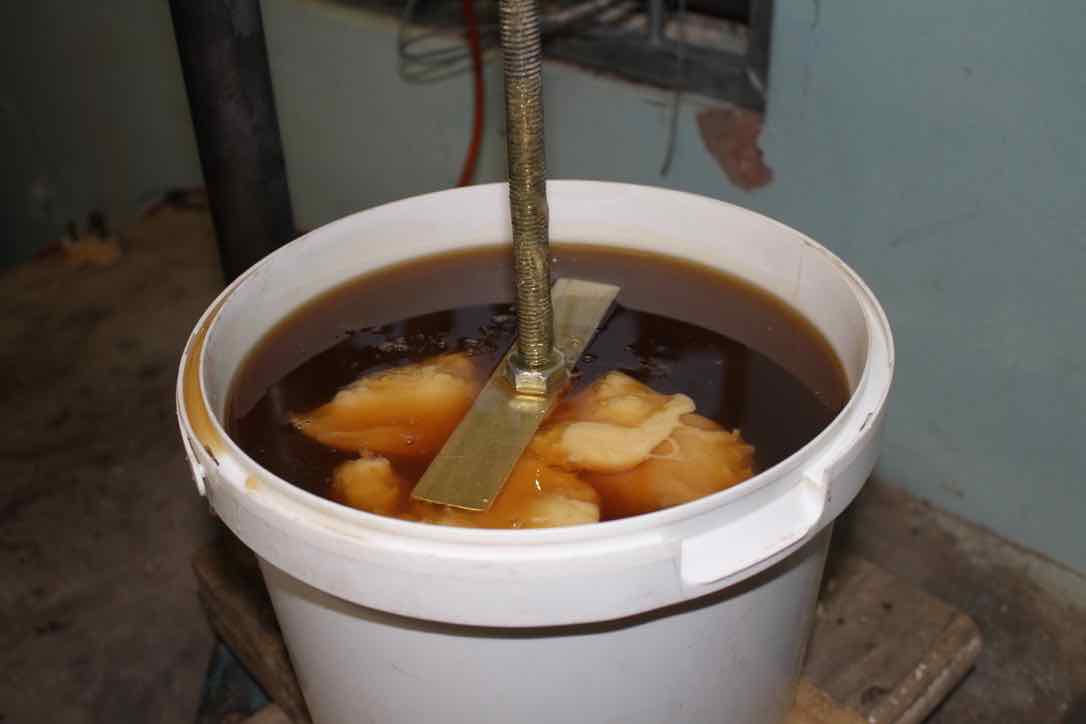
Creaming
And finally there is that which has been creamed. It is treated in the same way as set honey except that it is whipped for a much longer time with the specific intention of incorporating air into it; not unlike beaten egg whites. It is super-smooth, will actually pour; and is very nice for spreading on bread.
It tends to be expensive because of the extra processing but I personally have concerns about what effect the oxygen might have on the honey. And to muddy the waters, some unscrupulous bottlers may cream corn-syrup into it.
In short if you are a connoisseur and want decent honey that tastes wonderful and will not contribute to insulin-resistance find a small beekeeper you can talk to; or even consider keeping a hive or two in the garden. It really is a good option.
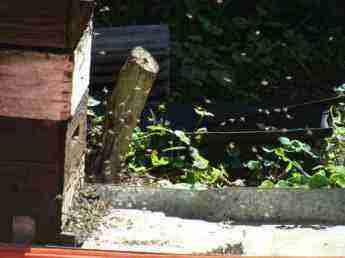
South Africa
South Africa consumers enjoy about 5 000 tons of honey per annum. In the 90's the country was self-sufficient. By 2014 local production had dropped to such an extent that we had to import about 3 500, most of it of very poor quality.
We produce liquid, crystallised and creamed honey; the quality compares very favourably with the best from anywhere in the world.
Natural raw honey is hard to come by; that is true all over the world. Commercial bottlers ruin it.
Researchers in Germany found that commercial honey has a very high glycemic index, yet unprocessed from hobbyist beekeepers the average GI is 54; that's low[2].
How do you fix crystallized honey?
The question reveals a lack of understanding. Crystallized honey does not need to be "fixed." It is in its most natural state. Any heating over 40oC will ruin it. If you insist on it being runny then rather go and buy the ultra-processed stuff from the grocery store. You do comprehend, I hope that it is highly glycemic; it will spike your blood sugar.
If you have a lot of patience and time on your hands, put the crystallized honey into a stainless-steel container and place it in a pot of water at no more than 104oF. Keep stirring; it will take for ever.
Crystallised and creamed honey
Crystallised and creamed honeys are natural sweeteners but beating the latter may be done to disguise adulteration with high-fructose corn syrup.
When browsing use right click and "Open Link in New Tab" or you may get a bad gateway signal.
Newsletter
Our newsletter is entitled "create a cyan zone" at your home, preserving both yourself and Mother Earth for future generations; and the family too, of course. We promise not to spam you with daily emails promoting various products. You may get an occasional nudge to buy one of my books.
Here are the back issues.
- Lifestyle and ideal body weight
- What are ultra-processed foods?
- Investing in long-term health
- Diseases from plastic exposure
- Intensive lifestyle management for obesity has limited value
- A world largely devoid of Parkinson's Disease
- The impact of friendly bacteria in the tum on the prevention of cancer
- There's a hole in the bucket
- Everyone is talking about weight loss drugs
- Pull the sweet tooth
- If you suffer from heartburn plant a susu
- Refined maize meal and stunting
- Should agriculture and industry get priority for water and electricity?
- Nature is calling
- Mill your own flour
- Bake your own sourdough bread
- Microplastics from our water
- Alternative types of water storage
- Wear your clothes out
- Comfort foods
- Create a bee-friendly environment
- Go to bed slightly hungry
- Keep bees
- Blue zone folk are religious
- Reduce plastic waste
- Family is important
- What can go in compost?
- Grow broad beans for longevity
- Harvest and store sunshine
- Blue zone exercise
- Harvest and store your rainwater
- Create a cyan zone at your home
Did you find this page interesting? How about forwarding it to a friendly book or food junkie? Better still, a social media tick would help.
- Bernard Preston homepage
- Our green garden
- Crystallised and Creamed Honey
Address:
56 Groenekloof Rd,
Hilton, KZN
South Africa
Website:
https://www.bernard-preston.com